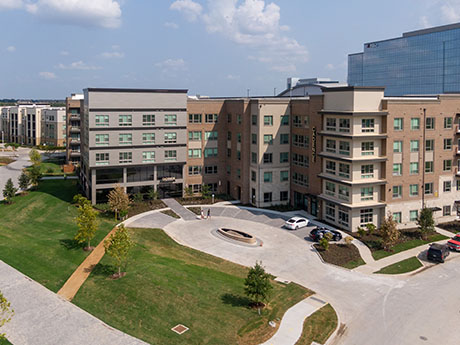By Chris McCluskey, vice president of development, VanTrust Real Estate; and Robert Folzenlogen, senior vice president of strategic development, Hillwood
In the past decade, the popularity of “live-work-play” developments has skyrocketed, making the concept a somewhat overused cliché in the commercial real estate world.
However, the reasoning behind the acclaim remains true — people love convenience and a sense of community. And “live-work-play” is the reason that cities like Frisco that are located outside dense urban cores have thrived.

Chris McCluskey, VanTrust Real Estate
According to the U.S. Census Bureau, Frisco’s population has grown by 71 percent over the last decade, consistently ranking as one of the fastest-growing cities in the nation. But this growth did not happen overnight; rather, a combination of ideal location and elected leaders’ vision has driven much of Frisco’s success.
By prioritizing all real estate classes — office, residential, retail — Frisco has been able to find the right balance between bustling urban amenities and the serene background of suburbia, making it one of the most competitive landscapes today and for the foreseeable future.
A Balanced Approach
Suburbs are no longer known for just their family appeal, although this feature still remains a high priority for many households. Young professionals are also looking to escape the expense of highly populated areas for the affordability these communities can offer, making a balanced approach to real estate development necessary for such markets. Frisco has combined both efforts by diversifying its housing options, emphasizing its great schools and entertainment districts and creating community gathering spots.

Robert Folzenlogen, Hillwood
Unlike many rising suburbs, Frisco has embraced multifamily development, bringing in countless projects to not only ensure affordability as the community grows, but also to guarantee the city’s overall appeal to the masses.
By welcoming mixed-use developments, Frisco is creating “live-work-play” hubs for young professionals looking for convenience and placing retail and office locations near neighborhoods for families still wanting to be close to amenities.
For instance, the developers of the 242-acre Frisco Station mixed-use destination have worked alongside the city to create one of these hubs. Adjacent to the Dallas Cowboys’ world headquarters, The Star, Frisco Station is adding all the essential real estate assets needed in that area in one destination.
Capitalizing on people’s love for accessibility and making the city more integrated and walkable at the same time, Frisco Station provides urban living, hotel accommodations and office space, as well as plans for a park system, a health and wellness district and an entertainment center.
By working alongside municipal leaders on all these uses, developers are creating a place that the entire community can use and giving employees, visitors and residents a very high quality of life.
Beyond the “live-work-play” hubs, Frisco has also emphasized a range of amenities throughout the city that feeds into the same concept. In addition to promoting an award-winning school district and various shopping areas, Frisco has also made a name for itself in sports.
Known as Sports City, USA, seven professional or semi-professional sports teams or organizations call the city home, including the Dallas Cowboys, FC Dallas, the Dallas Stars and the PGA of America. This concentration of athletics has significantly heightened Frisco’s appeal, offering families and young professionals numerous entertainment options within a few miles of their homes or workplaces.
An Upward Trajectory
In the last five years, instead of following the typical philosophy of “build it and they will come,” employers are taking the backseat, putting the power into their employees’ hands. Looking for increased job satisfaction and less turnover, companies want to be where employees are. In recent years, “live-work-play” communities like Frisco have proven capable of attracting these highly skilled workforces.
By partnering with the City of Frisco, development teams have achieved their goals of creating a regional destination that offers shorter commutes, increased work/life balance and flexible workspaces to the national labor pool.
As a result, employers have drawn labor not only from coastal areas where there is a lack of affordability, but also from local urban cores like Dallas, where opportunities can be scarce. Spurred also by the COVID-19 pandemic, this employee-first mindset, coupled with the “live-work-play” mentality, is bringing Frisco success even past its initial boom.
Additionally, Frisco, with its ideal location on both Texas State Highway 121 and U.S. Highway 380, offers tenants and their employees access to all the amenities the Dallas-Fort Worth (DFW) metroplex has to offer, including two major airports. This ensures that all employees and employers throughout Frisco — although further out from the typical urban core — still feel connected to the pro-business climate the entirety of DFW is known for.
A Stable Future
“Live-work-play” is rooted in the idea that people enjoy residing in an area that provides most of their essential needs in close proximity. Urban areas have functioned this way as a means of necessity for decades, often becoming oversized mixed-use developments themselves.
So naturally, as people began migrating to the suburbs, this convenience of urban living followed. However, to us, “live-work-play” has progressed beyond aspects of convenience, becoming what residents crave — a place for people to come together.
Unlike other suburbs in the metroplex that had to backtrack, Frisco uniquely had this mindset from the beginning, building out each real estate use and project with a forward-thinking approach to innovation. And as the city continues to see stable growth, reaching only 77 percent developed as of January 2022 according to city officials, this “live, work, play” approach will continue its success.
From the start, Frisco capitalized on its growth, knowing that no matter where people live, convenience and community are everything.
— This article originally appeared in the August 2022 issue of Texas Real Estate Business magazine.


